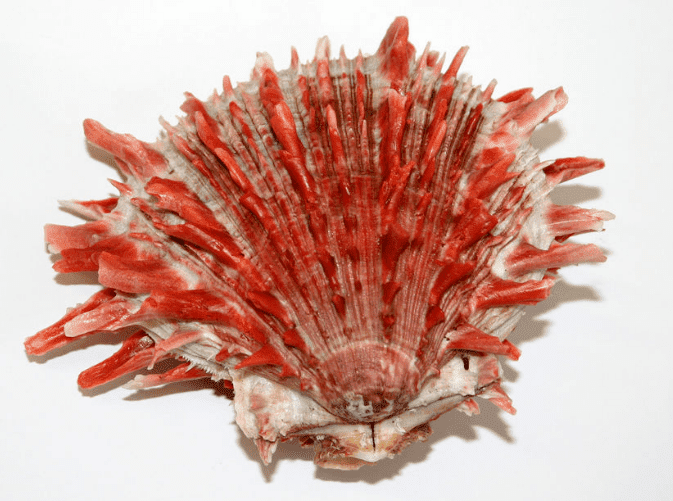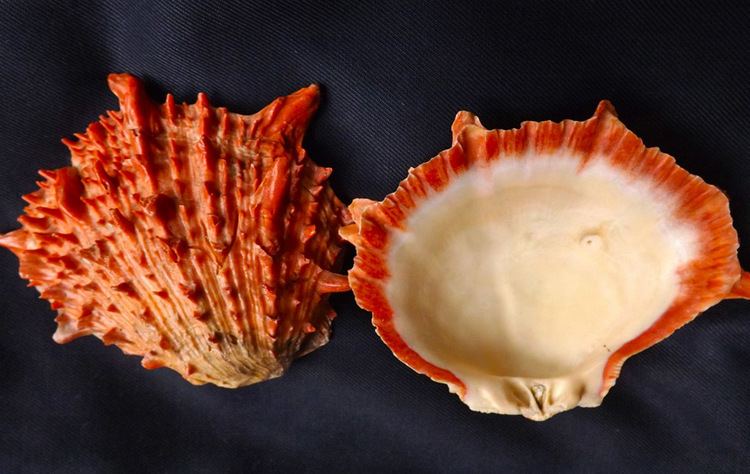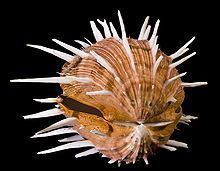Suborder Pectinina Family SpondylidaeGray, 1826 Higher classification Spondylidae Rank Genus | Order Pectinoida Scientific name Spondylus Subclass Pteriomorphia | |
 | ||
Similar Spondylidae, Bivalvia, Molluscs, Spondylus gaederopus, Pecten | ||
Spondylus 1
Spondylus is a genus of bivalve molluscs, the only genus in the family Spondylidae. As well as being the systematic or scientific name, Spondylus is the most often used common name for these animals, though they are also known as spondylids, thorny oysters, and spiny oysters (though they are not, in fact, oysters) . The meat of these bivalves is edible.
Contents

Pt spondylus 2011
Description

The many species of Spondylus vary considerably in appearance and range. They are grouped in the same superfamily as the scallops. They are not closely related to true oysters (family Ostreidae); however, they do share some habits such as cementing themselves to rocks rather than attach themselves by a byssus. Their key characteristic is that the two halves of their shells are joined with a ball-and-socket type of hinge rather than with a toothed hinge, as is more common in other bivalves. They also still retain vestigial anterior and posterior auricles ("ears", triangular shell flaps) along the hinge line, a common feature of scallops though not of oysters.

Like all scallops, Spondylus spp. have multiple eyes around the edges of their shells, and have relatively well-developed nervous systems. Their nervous ganglia are concentrated in the visceral region, with recognisable optic lobes connected to the eyes.
Spondylus shells are much sought after by collectors, and a lively commercial market exists for them.
History

The genus Spondylus originated in the Mesozoic era and it is known in the fossil records from the Triassic to the Quaternary (age range: from 235.0 to 0.0 million years ago). There are about 40 extinct species.
These molluscs can be found in fossil shells all over the world. They are present in cretaceaous rocks in the Fort Worth Formation of Texas and in the Trent River Formation of Vancouver as well as in other parts of North America.
Archaeological evidence indicates that people in Neolithic Europe were trading the shells of S. gaederopus to make bangles and other ornaments throughout much of the Neolithic period. The main use period appears to have been from around 5350 to 4200 BC. The shells were harvested from the Aegean Sea but were transported far into the center of the continent. In the LBK and Lengyel cultures, Spondylus shells from the Aegean Sea were worked into bracelets and belt buckles. Over time styles changed with the middle neolithic favouring generally larger barrel-shaped beads and the late neolithic smaller flatter and disk shaped beads. Significant finds of jewelry made from Spondylus shells were made at the Varna Necropolis. During the late Neolithic the use of Spondylus in grave goods appears to have been limited to women and children.
S. princeps is found off the coast of Colombia and Ecuador and has been important to Andean peoples since pre-Columbian times, serving as both an offering to the Pachamama and as currency. In fact, much like in Europe, the Spondylus shells also reached far and wide, as pre-Hispanic Ecuadorian peoples traded them with peoples as far north as present-day Mexico and as far south as the central Andes. The Moche people of ancient Peru regarded the sea and animals as sacred they used Spondylus shells in their art and depicted Spondylus in effigy pots. Spondylus were also harvested from the Gulf of California and traded to tribes through Mexico and the American Southwest.
